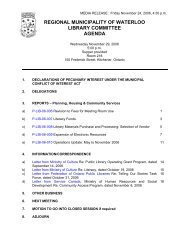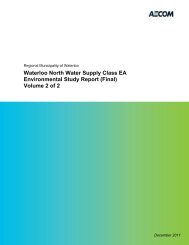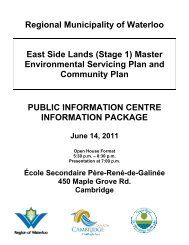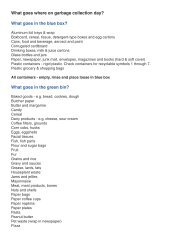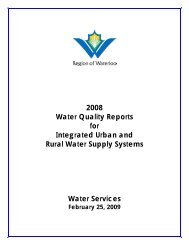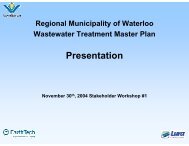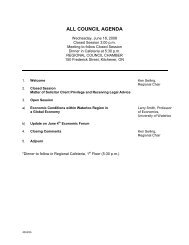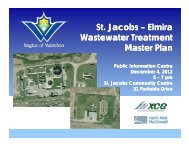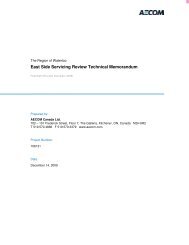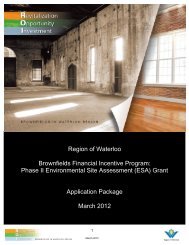Sam Ziemann From - Region of Waterloo
Sam Ziemann From - Region of Waterloo
Sam Ziemann From - Region of Waterloo
You also want an ePaper? Increase the reach of your titles
YUMPU automatically turns print PDFs into web optimized ePapers that Google loves.
HYDROGEOLOGICAL ASSESSMENTSTRANGE STREET WATER SUPPLY CLASS EA UPDATEREGIONAL MUNICIPALITY OF WATERLOOBackground ReviewMarch 19, 2012Huron-Georgian Bay ice lobes and is mainly restricted to the western flanks <strong>of</strong> the <strong>Waterloo</strong>Moraine. The Tavistock Till is a dark brown clayey silt till, similar in composition to the MaryhillTill, and may correspond to the isolated till units capping the <strong>Waterloo</strong> Moraine that are referredto by Karrow (1993) as the Maryhill Till. If this is the case, then the Tavistock Till may havebeen deposited within the Study Area along the eastern flank <strong>of</strong> the Moraine. The Port StanleyTill is similar in age to the Tavistock Till and was deposited by ice advancing from theErie-Ontario ice lobe and is mainly restricted to the eastern flanks <strong>of</strong> the <strong>Waterloo</strong> Morainewhich includes the study area. The Port Stanley Till is a sandy silt to silty sand till and isoccasionally stony.Figure 2 presents the surficial Quaternary geology for the general Study Area based oncompiled mapping by OGS (2003). The surficial geology within the Study Area consists <strong>of</strong>predominantly glaci<strong>of</strong>luvial sandy and gravelly deposits with occasional pockets <strong>of</strong> stone-poor,sandy silt to silty sand till and clay to silt textured till. Along the major surface water bodiesincluding the Grand River, Strasburg Creek and Schneider Creek, modern day alluvial depositshave been identified at surface (Figure 2).The Paleozoic bedrock geology beneath the Study Area consists <strong>of</strong> the Salina and GuelphFormations. The Salina Formation consists <strong>of</strong> interbedded brown dolostone and grey to greenshale with lenses <strong>of</strong> gypsum and anhydrite. Typically, groundwater extracted from the SalinaFormation within the <strong>Region</strong> is <strong>of</strong> poor quality due to high concentrations <strong>of</strong> calcium andsulphate resulting from the dissolution <strong>of</strong> gypsum and anhydrite minerals. The GuelphFormation is a cream-coloured crystalline dolostone and represents an important supply aquiferto the northeast in the area <strong>of</strong> Guelph, and to the east in the City <strong>of</strong> Cambridge. The contactbetween the Salina and Guelph Formations is interpreted to be slightly west <strong>of</strong> the Study Area.2.3.1 HydrostratigraphyA comprehensive review <strong>of</strong> the geology and hydrogeology <strong>of</strong> the <strong>Waterloo</strong> Moraine wasundertaken as part <strong>of</strong> the Study <strong>of</strong> the Hydrogeology <strong>of</strong> the <strong>Waterloo</strong> Moraine in 1995(Terraqua, 1995). As part <strong>of</strong> this work, a conceptual hydrogeologic model for the moraine wasdeveloped, consisting <strong>of</strong> three overburden aquifers (Aquifers 1, 2, 3), separated by fouraquitards (Aquitards 1, 2, 3, 4). The upper portion <strong>of</strong> the bedrock aquifer in the area wasclassified as the fourth aquifer unit (Aquifer 4).Recent work by Bajc and Shirota (2007) resulted in a conceptual geological model for the<strong>Region</strong> that consists <strong>of</strong> an aquifer/aquitard sequence with 19 layers. Many <strong>of</strong> these layers arefound only locally. Nine layers were identified to be the most regionally significant, andgenerally correspond with those presented by Terraqua (1995). In the naming convention usedby Bajc and Shirota (2007) aquitard units are identified with AT followed by a letter and number(e.g., ATB1), whereas aquifers are identified with AF followed by a letter and number(e.g., AFB1).hls v:\01609\active\161110897_strange_st\planning\report\final hydrogeo assessment\final\fnl_rpt_120319.docx 2.3



